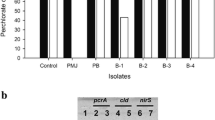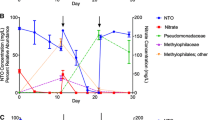Abstract
Recent studies have shown that perchlorate (ClO4 −) can be degraded by some pure-culture and mixed-culture bacteria with the addition of hydrogen. This paper describes the isolation of two hydrogen-utilizing perchlorate-degrading bacteria capable of using inorganic carbon for growth. These autotrophic bacteria are within the genus Dechloromonas and are the first Dechloromonas species that are microaerophilic and incapable of growth at atmospheric oxygen concentrations. Dechloromonas sp. JDS5 and Dechloromonas sp. JDS6 are the first perchlorate-degrading autotrophs isolated from a perchlorate-contaminated site. Measured hydrogen thresholds were higher than for other environmentally significant, hydrogen-utilizing, anaerobic bacteria (e.g., halorespirers). The chlorite dismutase activity of these bacteria was greater for autotrophically grown cells than for cells grown heterotrophically on lactate. These bacteria used fumarate as an alternate electron acceptor, which is the first report of growth on an organic electron acceptor by perchlorate-reducing bacteria.


Similar content being viewed by others
References
Achenbach LA, Michaelidou U, Bruce RA, Fryman J, Coates JD (2001) Dechlorosomas agitata gen. nov., sp nov and Dechlorosoma suillum gen. nov., sp nov., two novel environmentally dominant (per)chlorate-reducing bacteria and their phylogenetic position. Int J Syst Evol Microbiol 51:527–533
APHA, AWWA, WEF (1989) Standard methods for examination of water and wastewater. APHA, Washington, D.C.
Benson HJ (1998) Microbiological applications: complete version lab manual, 7th edn. McGraw–Hill, Boston
Bertsova YV, Bogachev AV, Skulachev VP (1998) Two NADH:ubiquinone oxidoreductases of Azotobacter vinelandii and their role in the respiratory protection. Biochim Biophys Acta Bioenerg 1363:125–133
Brechner RJ, Parkhurst GD, Humble WO, Brown MB, Herman WH (2000) Ammonium perchlorate contamination of colorado river drinking water is associated with abnormal thyroid function in newborns in Arizona. J Occup Environ Med 42:777–782
Breznak J (1994) Acetogenesis from carbon dioxide in termite guts. In: Drake HL (ed) Acetogenesis. Chapman & Hall, New York, pp 303–330
Bruce RA, Achenbach LA, Coates JD (1999) Reduction of (per)chlorate by a novel organism isolated from paper mill waste. Environ Microbiol 1:319–329
Chaudhuri SK, O’Connor SM, Gustavson RL, Achenbach LA, Coates JD (2002) Environmental factors that control microbial perchlorate reduction. Appl Environ Microbiol 68:4425–4430
Coates JD, Michaelidou U, Bruce RA, O’Connor SM, Crespi JN, Achenbach LA (1999) Ubiquity and diversity of dissimilatory (per)chlorate-reducing bacteria. Appl Environ Microbiol 65:5234–5241
Conrad R (1996) Soil microorganisms as controllers of atmospheric trace gases (H-2, CO, CH4, OCS, N2O, and NO). Microbiol Rev 60:609–640
Cord-Ruwisch R, Seitz HJ, Conrad R (1988) The capacity of hydrogenotrophic anaerobic-bacteria to compete for traces of hydrogen depends on the redox potential of the terminal electron-acceptor. Arch Microbiol 149:350–357
Giblin TL, Herman DC, Frankenberger WT (2000) Removal of perchlorate from ground water by hydrogen-utilizing bacteria. J Environ Qual 29:1057–1062
Hagedoorn PL, Geus DC de, Hagen WR (2002) Spectroscopic characterization and ligand-binding properties of chlorite dismutase from the chlorate respiring bacterial strain GR-1. Eur J Biochem 269:4905–4911
Harwood CS, Parales RE (1996) The β-ketoadipate pathway and the biology of self-identity. Annu Rev Microbiol 50:553–590
Hungate RE (1969) A roll tube method for cultivation of strict anaerobes. Methods Microbiol 3B:117–132
Jeanmougin F, Thompson JD, Gouy M, Higgins DG, Gibson TJ (1998) Multiple sequence alignment with Clustal X. Trends Biochem Sci 23:403–405
Kengen SW, Rikken GB, Hagen WR, Ginkel CG van, Stams AJ (1999) Purification and characterization of (per)chlorate reductase from the chlorate-respiring strain GR-1. J Bacteriol 181:6706–6711
Kim YC, Miller CD, Anderson AJ (1999) Transcriptional regulation by iron of genes encoding iron- and manganese-superoxide dismutases from Pseudomonas putida. Gene 239:129–135
Leclere V, Chotteau-Lelievre A, Gancel F, Imbert M, Blondeau R (2001) Occurrence of two superoxide dismutases in Aeromonas hydrophila: molecular cloning and differential expression of the sodA and sodB genes. Microbiology 147:3105–3111
Logan BE (1998) A review of chlorate- and perchlorate-respiring microorganisms. Biorem J 2:69–79
Logan BE (2001) Assessing the outlook for perchlorate remediation. Environ Sci Technol 35:483A–487A
Logan BE, Zhang HS, Mulvaney P, Milner MG, Head IM, Unz RF (2001) Kinetics of perchlorate- and chlorate-respiring bacteria. Appl Environ Microbiol 67:2499–2506
Lovley DR (1985) Minimum threshold for hydrogen metabolism in methanogenic bacteria. Appl Environ Microbiol 49:1530–1531
Lovley DR, Goodwin S (1988) Hydrogen concentrations as an indicator of the predominant terminal electron-accepting reactions in aquatic sediments. Geochim Cosmochim Acta 52:2993–3003
Lovley DR, Chapelle FH, Woodward JC (1994) Use of dissolved H(2) concentrations to determine distribution of microbially catalyzed redox reactions in anoxic groundwater. Environ Sci Technol 28:1205–1210
Löffler FE, Tiedje JM, Sanford RA (1999) Fraction of electrons consumed in electron acceptor reduction and hydrogen thresholds as indicators of halorespiratory physiology. Appl Environ Microbiol 65:4049–4056
Miller JP, Logan BE (2000) Sustained perchlorate degradation in an autotrophic, gas-phase, packed-bed bioreactor. Environ Sci Technol 34:3018–3022
Nerenberg, R, Rittmann BE (2002) Perchlorate as a secondary substrate in a denitrifying, hollow-fiber membrane biofilm reactor. Water Sci Technol Water Suppl 2:259–265
Rikken GB, Kroon AGM, vanGinkel CG (1996) Transformation of (per)chlorate into chloride by a newly isolated bacterium: reduction and dismutation. Appl Microbiol Biotechnol 45:420–426
Sawyer CN, McCarty PL, Parkin GF (2003) Chemistry for environmental engineering, 5th edn. McGraw–Hill, New York
Schäfer H, Muyzer G (2001) Denaturing gradient gel electrophoresis in marine microbial ecology. Methods Microbiol 30:425–468
Smith PN, Theodorakis CW, Anderson TA, Kendall RJ (2001) Preliminary assessment of perchlorate in ecological receptors at the Longhorn army ammunition plant (LHAAP), Karnack, Texas. Ecotoxicology 10:305–313
Stenklo K, Thorell HD, Bergius H, Aasa R, Nilsson T (2001) Chlorite dismutase from Ideonella dechloratans. J Biol Inorg Chem 6:601–607
Swofford D (2002) PAUP*. Phylogenetic analysis using parsimony (*and other methods). Sinauer, Sunderland
Urbansky ET, Schock MR (1999) Issues in managing the risks associated with perchlorate in drinking water. J Environ Manage 56:79–95
Wallace W, Ward T, Breen A, Attaway H (1996) Identification of an anaerobic bacterium which reduces perchlorate and chlorate as Wolinella succinogenes. J Ind Microbiol 16:68–72
White D (2000) The physiology and biochemistry of prokaryotes, 2nd edn. Oxford, New York
Wilhelm E, Battino R, Wilcock RJ (1977) Low pressure solubility of gases in liquid water. Chem Rev 77:219–262
Wolterink A, Jonker AB, Kengen SWM, Stams AJM (2002) Pseudomonas chloritidismutans sp. nov., a nondenitrifying, chlorate-reducing bacterium. Int J Syst Evol Microbiol 52:2183–2190
Zhang HS, Bruns MA, Logan BE (2002) Perchlorate reduction by a novel chemolithoautotrophic, hydrogen-oxidizing bacterium. Environ Microbiol 4:570–576
Acknowledgements
This work was funded by the United States Army Operations Command (grant program DAAA09-00-C-0016) and the University of Iowa–National Science Foundation Research Training Grant (DBI-96-02247). Special thanks are due to Romy Chakraborty, Kimberly A. Cole, Jay Pollock, and John D. Coates of Southern Illinois University and University of California–Berkeley for their assistance and for providing D. agitata strain CKB. Andrew Hawkins and Caroline S. Harwood provided assistance with molecular techniques. Craig Just provided assistance with analytical measurements.
Author information
Authors and Affiliations
Corresponding author
Rights and permissions
About this article
Cite this article
Shrout, J.D., Scheetz, T.E., Casavant, T.L. et al. Isolation and characterization of autotrophic, hydrogen-utilizing, perchlorate-reducing bacteria. Appl Microbiol Biotechnol 67, 261–268 (2005). https://doi.org/10.1007/s00253-004-1725-0
Received:
Revised:
Accepted:
Published:
Issue Date:
DOI: https://doi.org/10.1007/s00253-004-1725-0




